Effect of Heat Treatment on the Microstructure and Mechanical Properties of a Ti-TiAl Laminate Composite
Abstract
:1. Introduction
2. Materials and Methods
3. Results and Discussions
3.1. Microstructure Evolution
3.2. Tensile Properties
3.3. Fracture Toughness
4. Conclusions
- (1)
- The plasticity and fracture toughness of composites are successfully enhanced by heat treatment without sacrificing strength too much. The E.L. of the HT3 composite is nearly two times higher than the initial one. Meanwhile, the UTS of the HT3 composite is only reduced by 2.7%.
- (2)
- With the increase in primary annealing temperature, the UTS of composites shows a tendency to first increase and then decrease, but E.L. continuously increased. The secondary annealing temperature has less influence on the UTS and E.L. of composites. The fracture toughness of composites in two directions is enhanced with the increase in primary and secondary annealing temperature.
- (3)
- The decrease in dislocations, substructures and residual stresses stored in the TiAl alloy and interfacial region, as well as the acicular α2 phase precipitated at the interfacial region, are the main reasons for plasticity improvement. The strength of composites is enhanced by precipitated dual-scale silicides.
- (4)
- After heat treatment at 940–960 °C/2 h/AC + 725–750 °C/6 h/AC, the composite may possess a high, comprehensive mechanical property. In this study, the HT3 composite possesses the optimal comprehensive mechanical properties. The UTS and E.L. at 25 °C and 700 °C are 852 MPa and 2.0% and 615 MPa and 12.9%, respectively. The fracture toughness in the AO and DO are 32.8 MPa·m1/2 and 30.8 MPa·m1/2, respectively.
Author Contributions
Funding
Institutional Review Board Statement
Informed Consent Statement
Data Availability Statement
Conflicts of Interest
References
- Ding, J.; Zhang, M.; Liang, Y.; Ren, Y.; Dong, C.; Lin, J. Enhanced high-temperature tensile property by gradient twin structure of duplex high-Nb-containing TiAl alloy. Acta Mater. 2018, 161, 1–11. [Google Scholar] [CrossRef]
- Erdely, P.; Staron, P.; Maawad, E.; Schell, N.; Clemens, H.; Mayer, S. Lattice and phase strain evolution during tensile loading of an intermetallic, multi-phase γ-TiAl based alloy. Acta Mater. 2018, 158, 193–205. [Google Scholar] [CrossRef]
- Zhu, B.; Xue, X.Y.; Kou, H.C.; Li, X.L.; Li, J.S. Effect of microstructure on the fracture toughness of multi-phase high Nb-containing TiAl alloys. Intermetallics 2018, 100, 142–150. [Google Scholar] [CrossRef]
- Kim, J.Y.; Park, E.S.; Lee, T.; Ryu, S.; Kim, S.E.; Kim, S.W. Origin of enhanced room temperature ductility in TiAl alloys: Reducing activation difference of deformation mechanism of γ phase. J. Alloys Compd. 2022, 899, 163307. [Google Scholar] [CrossRef]
- Cui, S.; Cui, C.X.; Yang, S.C.; Liu, S.J. Microstructure and mechanical properties of hybrid in-situ Ti2AlCw/Mo2B5p reinforced TiAl alloy. Mater. Sci. Eng. A 2022, 829, 142182. [Google Scholar] [CrossRef]
- Cui, N.; Wu, Q.; Bi, K.; Wang, J.; Xu, T.; Kong, F. Effect of multi-directional forging on the microstructure and mechanical properties of β-solidifying TiAl alloy. Materials 2019, 12, 1381. [Google Scholar] [CrossRef] [PubMed] [Green Version]
- Zhang, Y.; Wang, X.; Kong, F.; Sun, L.; Chen, Y. A high-performance β-solidifying TiAl alloy sheet: Multi-type lamellar microstructure and phase transformation. Mater. Charact. 2018, 138, 136–144. [Google Scholar] [CrossRef]
- Narayana, P.L.; Li, C.-L.; Kim, S.-W.; Kim, S.-E.; Marquardt, A.; Leyens, C.; Reddy, N.S.; Yeom, J.-T.; Hong, J.-K. High strength and ductility of electron beam melted β stabilized γ-TiAl alloy at 800 °C. Mater. Sci. Eng. A 2019, 756, 41–45. [Google Scholar] [CrossRef]
- Liu, Y.; Li, J.; Tang, B.; Wang, W.Y.; Lai, M.; Zhu, L.; Kou, H. Formation mechanism of γ twins in β-solidified γ-TiAl alloys. J. Mater. Sci. Technol. 2022, 105, 164–171. [Google Scholar] [CrossRef]
- Sun, W.; You, F.H.; Kong, F.T.; Wang, X.P.; Chen, Y.Y. Effect of residual stresses on the mechanical properties of Ti-TiAl laminate composites fabricated by hot-pack rolling. Mater. Charact. 2020, 166, 110394. [Google Scholar] [CrossRef]
- Sun, W.; Fan, H.; You, F.; Kong, F.; Wang, X.; Chen, Y. Prediction of interfacial phase formation and mechanical properties of Ti6Al4V–Ti43Al9V laminate composites. Mater. Sci. Eng. A 2020, 782, 139173. [Google Scholar] [CrossRef]
- Sun, W.; You, F.; Kong, F.; Wang, X.; Chen, Y. Fracture mechanism of a high tensile strength and fracture toughness Ti6Al4V–TiAl laminated composite. J. Alloys Compd. 2020, 820, 153088. [Google Scholar] [CrossRef]
- Sun, W.; You, F.; Kong, F.; Wang, X.; Chen, Y. Enhanced tensile strength and fracture toughness of a Ti-TiAl metal-intermetallic laminate (MIL) composite. Intermetallics 2020, 118, 106684. [Google Scholar] [CrossRef]
- Bermejo, R.; Torres, Y.; Sanchez-Herencia, A.J.; Baudin, C.; Anglada, M.; Llanes, L. Residual stresses, strength and toughness of laminates with different layer thickness ratios. Acta Mater. 2006, 54, 4745–4757. [Google Scholar] [CrossRef]
- Yuan, M.; Wang, Z.; Yao, Y.; Li, L. Finite element analysis of thermal stresses in Ti-Al3Ti metal-intermetallic laminated composites. Results Phys. 2019, 15, 102706. [Google Scholar] [CrossRef]
- Zhou, H.T.; Kong, F.T.; Wu, K.; Wang, X.P.; Chen, Y.Y. Hot pack rolling nearly lamellar Ti-44Al-8Nb-(W, B, Y) alloy with different rolling reductions: Lamellar colonies evolution and tensile properties. Mater. Des. 2017, 121, 202–212. [Google Scholar] [CrossRef]
- Li, T.R.; Liu, G.H.; Xu, M.; Wang, B.X.; Niu, H.Z.; Misra, R.D.K.; Wang, Z.D. Effects of hot-pack rolling process on microstructure, high-temperature tensile properties, and deformation mechanisms in hot-pack rolled thin Ti–44Al–5Nb-(Mo, V, B) sheets. Mater. Sci. Eng. A 2019, 764, 138197. [Google Scholar] [CrossRef]
- Sun, W.; Yang, F.; Kong, F.; Wang, X.; Chen, Y. Interface characteristics of Ti6Al4V-TiAl metal-intermetallic laminate (MIL) composites prepared by a novel hot-pack rolling. Mater. Charact. 2018, 144, 173–181. [Google Scholar] [CrossRef]
- Wang, X.R.; Yang, Y.Q.; Luo, X.; Zhang, W.; Zhao, G.M.; Huang, B. An investigation of Ti-43Al-9V/Ti-6Al-4V interface by diffusion bonding. Intermetallics 2013, 36, 127–132. [Google Scholar] [CrossRef]
- Su, Y.; Fan, H.; You, F.; Kong, F.; Wang, X.; Chen, Y. Improved tensile properties of a novel near-α titanium alloy via tailoring microstructure by hot-rolling. Mater. Sci. Eng. A 2020, 790, 139588. [Google Scholar] [CrossRef]
- Tian, Y.; Wang, E.H.; Li, W.; Niu, Z.Y.; Chang, Y.P.; Guo, C.H.; Wang, Z.Q.; Leng, Z.; Jiang, F.C. Improved fracture toughness of NiTi shape memory alloy fiber-reinforced Ti-Al metal-intermetallic-laminate composite. J. Alloys Compd. 2018, 739, 669–677. [Google Scholar] [CrossRef]
- Chen, X.F.; Tang, B.; Liu, D.; Wei, B.B.; Zhu, L.; Liu, R.C.; Kou, H.C.; Li, J.S. Dynamic recrystallization and hot processing map of Ti-48Al-2Cr-2Nb alloy during the hot deformation. Mater. Charact. 2021, 179, 111332. [Google Scholar] [CrossRef]
- Singh, V.; Mondal, C.; Sarkar, R.; Bhattacharjee, P.P.; Ghosal, P. Dynamic recrystallization of a β(B2)-Stabilized γ-TiAl based Ti–45Al–8Nb–2Cr-0.2B alloy: The contributions of constituent phases and Zener-Hollomon parameter modulated recrystallization mechanisms. J. Alloys Compd. 2020, 828, 154386. [Google Scholar] [CrossRef]
- Jia, R.; Zeng, W.; Zhao, Z.; Zhang, P.; Xu, J.; Wang, Q. In-situ investigation on the deformation mechanism of duplex microstructure of a near α titanium alloy. J. Alloys Compd. 2022, 893, 162184. [Google Scholar] [CrossRef]
- Ma, Y.; Youssef, S.S.; Feng, X.; Wang, H.; Huang, S.; Qiu, J.; Lei, J.; Yang, R. Fatigue crack tip plastic zone of α + β titanium alloy with Widmanstatten microstructure. J. Mater. Sci Technol. 2018, 34, 2107–2115. [Google Scholar] [CrossRef]
- Nambu, S.; Michiuchi, M.; Inoue, J.; Koseki, T. Effect of interfacial bonding strength on tensile ductility of multilayered steel composites. Compos. Sci. Technol. 2009, 69, 1936–1941. [Google Scholar] [CrossRef]
- Zhang, Y.J.; Cheng, X.W.; Cai, H.N.; Zhang, H.M. Effects of annealing time on the microstructures and tensile properties of formed laminated composites in Ti-Ni system. J. Alloys Compd. 2017, 699, 695–705. [Google Scholar] [CrossRef]
- Wang, S.; An, Q.; Zhang, R.; Jiang, S.; Huang, L.J.; Chen, R.; Liu, B.X.; Jiao, Y.; Geng, L. Microstructure characteristics and enhanced properties of network-structured TiB/(TA15-Si) composites via rolling deformation at different temperatures. Mater. Sci. Eng. A 2022, 829, 142176. [Google Scholar] [CrossRef]
- Xu, S.; Zhou, Z.; Long, F.; Jia, H.; Guo, N.; Yao, Z.; Daymond, M.R. Combination of back stress strengthening and Orowan strengthening in bimodal structured Fe–9Cr–Al ODS steel with high Al addition. Mater. Sci. Eng. A 2019, 739, 45–52. [Google Scholar] [CrossRef]
- Dieter, G.E.; Bacon, D.J. Mechanical Metallurgy; McGraw-hill: New York, NY, USA, 1976. [Google Scholar]
- Griffith, A. The phenomena of rupture and flow in solid. Philos. Trans. R Soc. A Math. Phys. Eng. Sci. 1920, 221, 163–198. [Google Scholar]
- Lesuer, D.R.; Syn, C.K.; Sherby, O.D.; Wadsworth, J.; Lewandowski, J.J.; Hunt, W.H. Mechanical behaviour of laminated metal composites. Int. Mater. Rev. 1996, 41, 169–197. [Google Scholar] [CrossRef]
- Shi, Z.F.; Guo, H.Z.; Zhang, J.W.; Yin, J.N. Microstructure−fracture toughness relationships and toughening mechanism of TC21 titanium alloy with lamellar microstructure. Trans. Nonferrous Met. Soc. China 2018, 28, 2440–2448. [Google Scholar] [CrossRef]
- Ding, H.; Cui, X.P.; Gao, N.N.; Sun, Y.; Zhang, Y.Y.; Huang, L.J.; Geng, L. Fabrication of (TiB/Ti)-TiAl composites with a controlled laminated architecture and enhanced mechanical properties. J. Mater. Sci. Technol. 2021, 62, 221–233. [Google Scholar] [CrossRef]
- Cui, X.; Fan, G.; Huang, L.; Gong, J.; Wu, H.; Zhang, T.; Geng, L.; Meng, S. Preparation of a novel layer-structured Ti3Al matrix composite sheet by liquid–solid reaction between Al foils and TiB/Ti composite foils. Mater. Des. 2016, 101, 181–187. [Google Scholar] [CrossRef]
- Qin, S.H.; Cui, X.P.; Tian, Z.; Geng, L.; Liu, B.X.; Zhang, J.E.; Chen, J.F. Synthesis and mechanical properties of innovative (TiB/Ti)-Ti3Al micro-laminated composites. J. Alloys Compd. 2017, 700, 122–129. [Google Scholar] [CrossRef]
- Zhu, H.; Sun, W.; Kong, F.; Wang, X.; Song, Z.; Chen, Y. Interfacial characteristics and mechanical properties of TiAl/Ti6Al4V laminate composite (LMC) fabricated by vacuum hot pressing. Mater. Sci. Eng. A 2019, 742, 704–711. [Google Scholar] [CrossRef]
- Lyu, S.Y.; Sun, Y.B.; Ren, L.; Xiao, W.L.; Ma, C.L. Simultaneously achieving high tensile strength and fracture toughness of Ti/Ti-Al multilayered composites. Intermetallics 2017, 90, 16–22. [Google Scholar] [CrossRef]
- Li, D.; Wang, B.; Luo, L.; Li, X.; Xu, Y.; Li, B.; Hawezy, D.; Wang, L.; Su, Y.; Guo, J.; et al. Effect of processing parameters on the microstructure and mechanical properties of TiAl/Ti2AlNb laminated composites. J. Mater. Sci. Technol. 2022, 109, 228–244. [Google Scholar] [CrossRef]
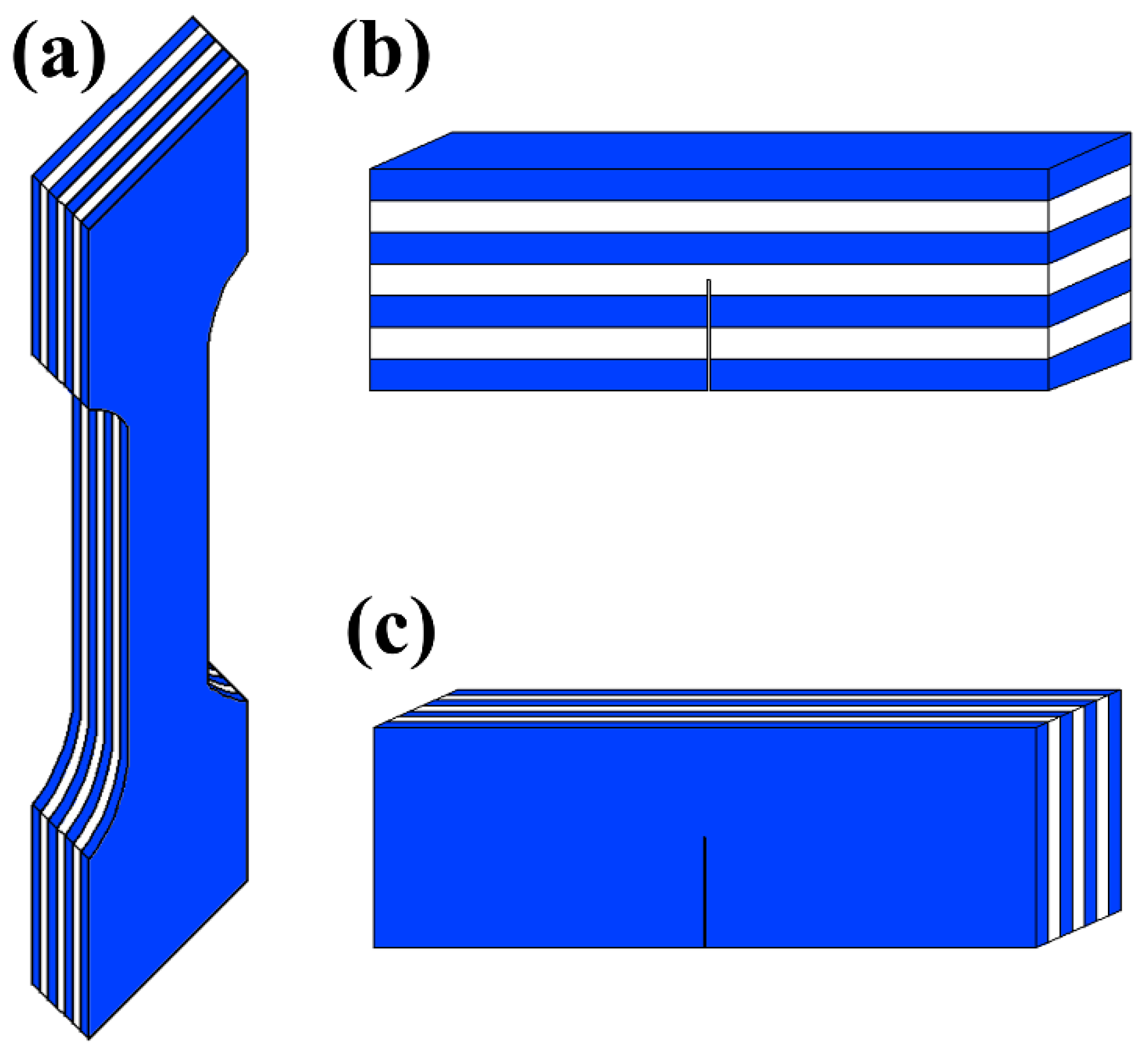

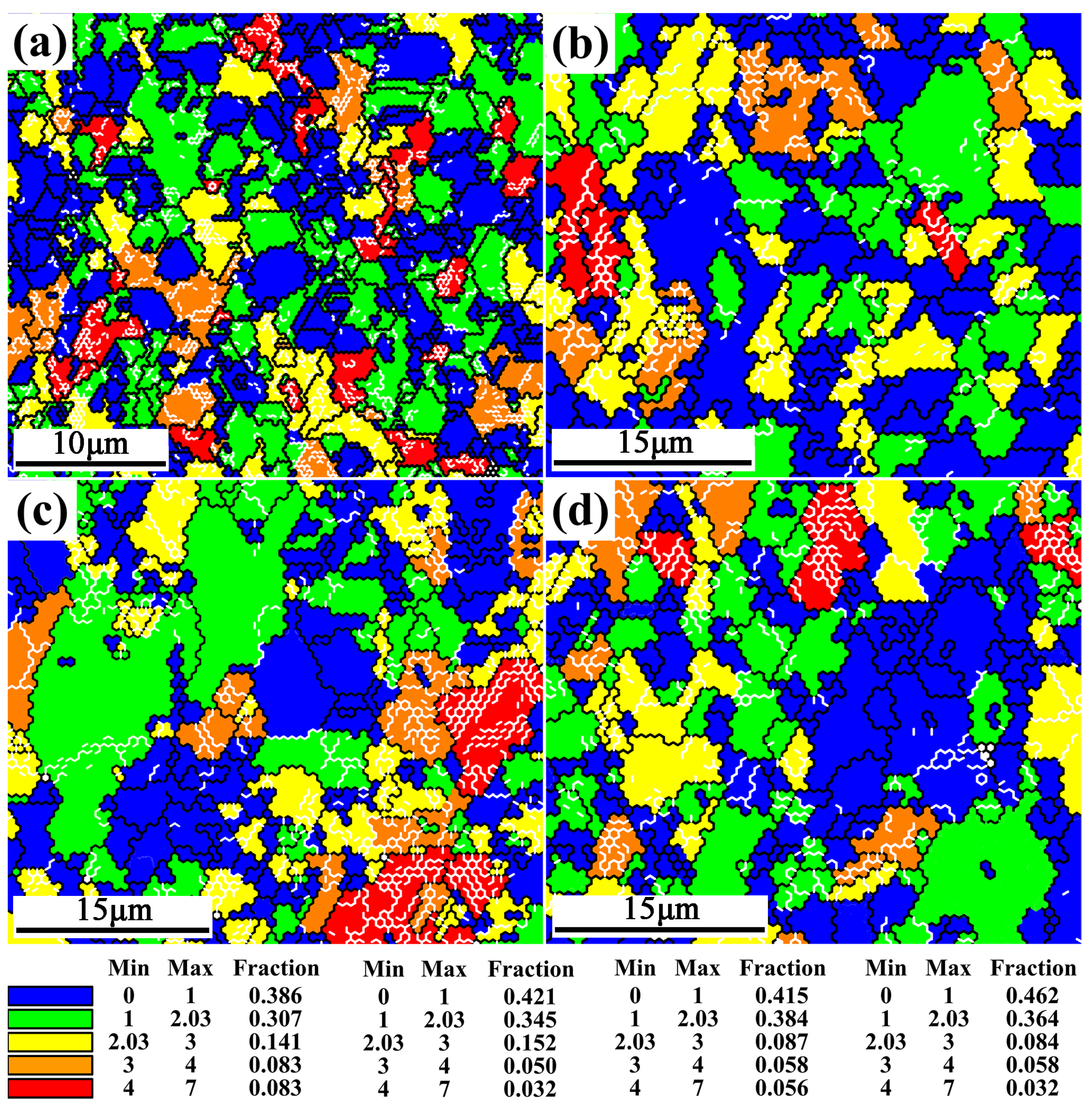




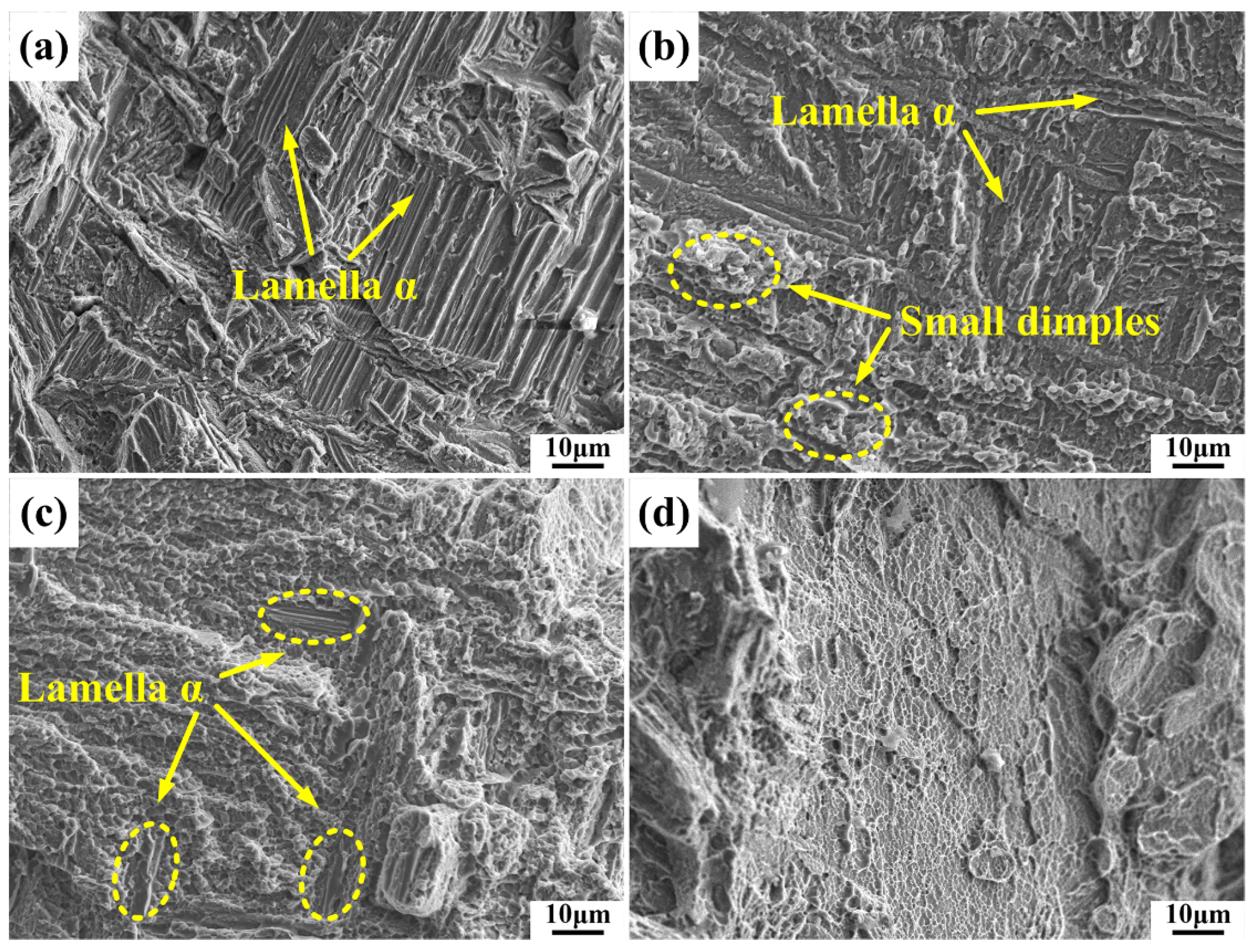
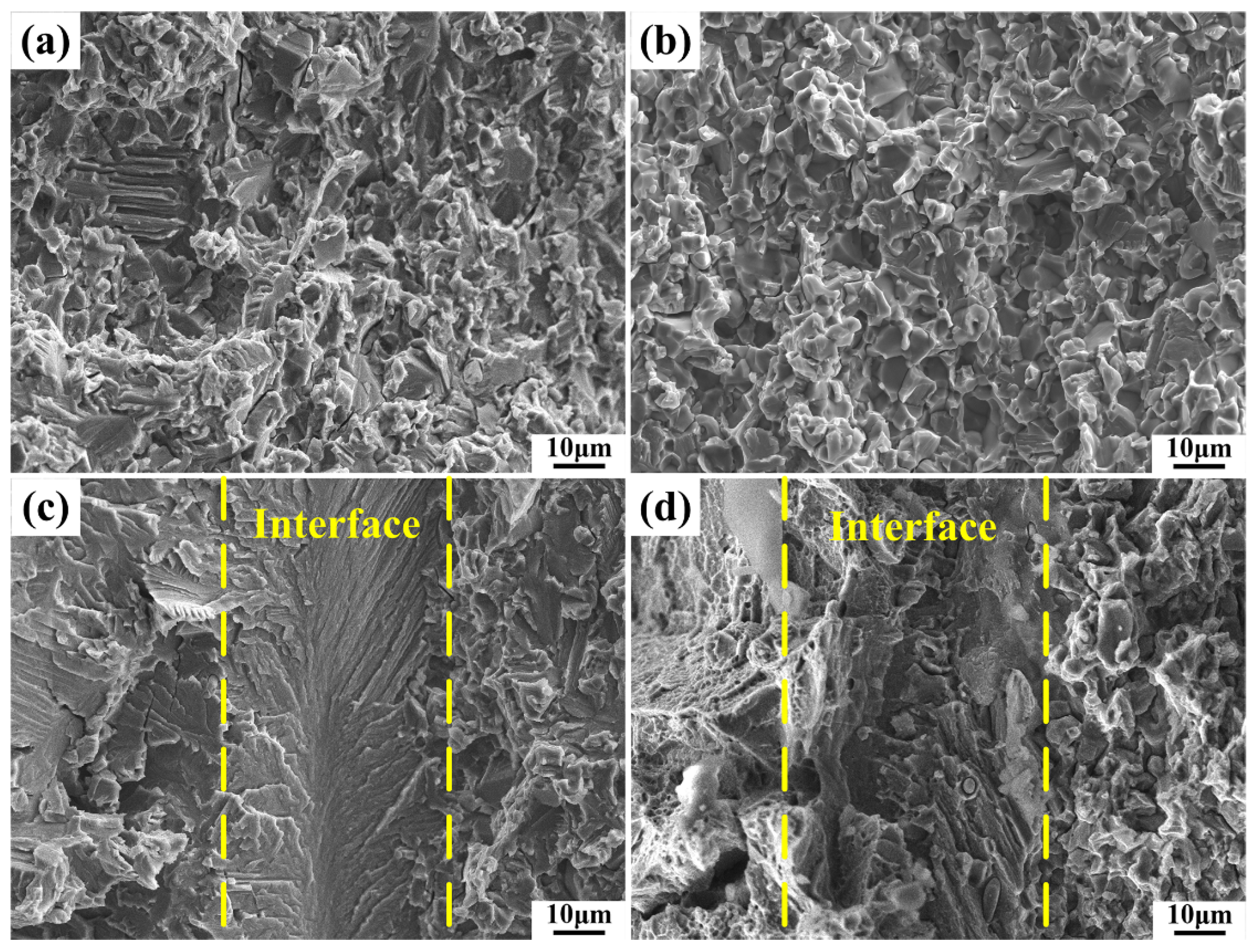

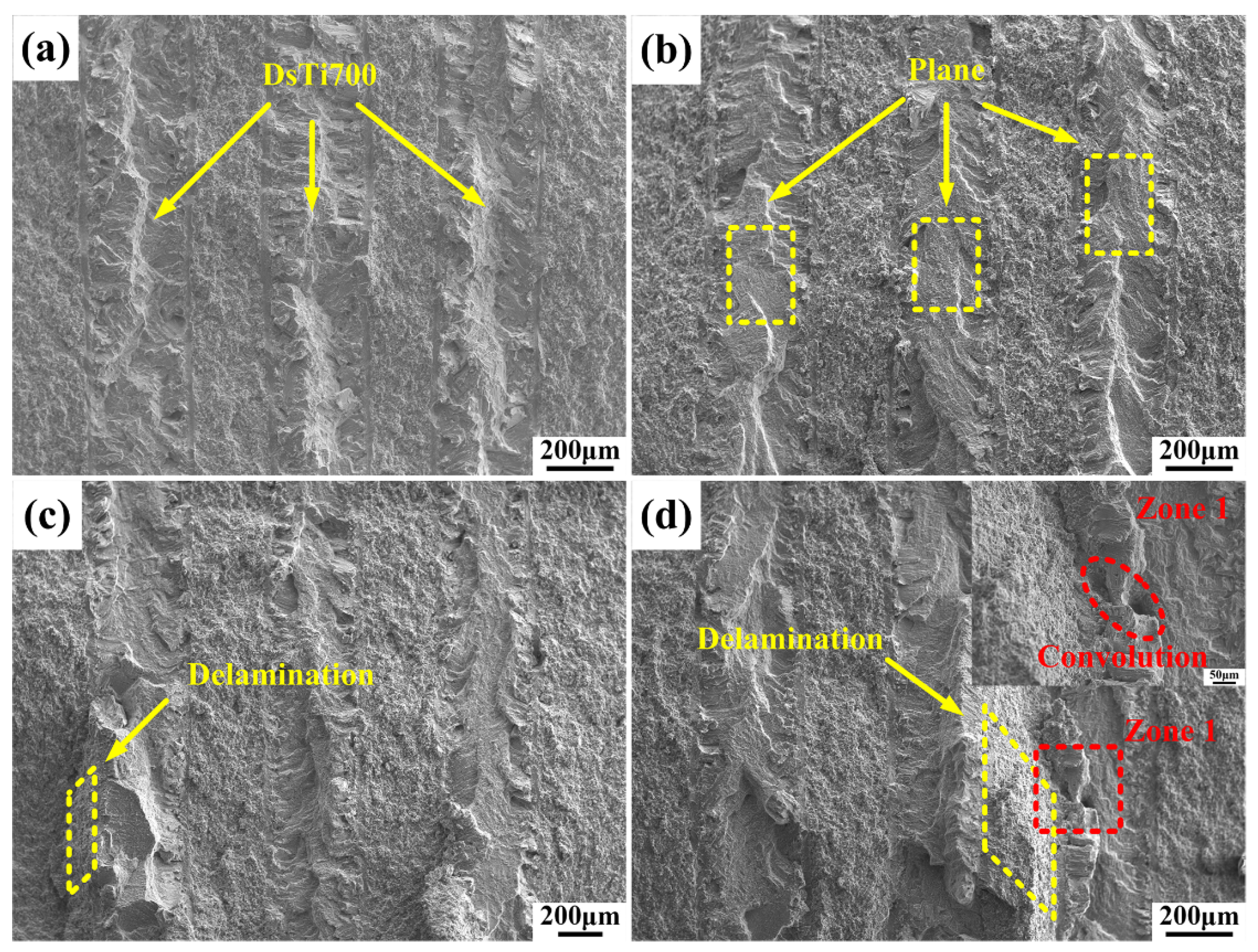
| No. | Primary Annealing | Secondary Annealing |
|---|---|---|
| HT1 | 920 °C/2 h/AC | 725 °C/6 h/AC |
| HT2 | 940 °C/2 h/AC | 700 °C/6 h/AC |
| HT3 | 940 °C/2 h/AC | 725 °C/6 h/AC |
| HT4 | 940 °C/2 h/AC | 750 °C/6 h/AC |
| HT5 | 960 °C/2 h/AC | 725 °C/6 h/AC |
| NO. | 25 °C Tensile Properties | 700 °C Tensile Properties | ||
|---|---|---|---|---|
| UTS (MPa) | E.L. (%) | UTS (MPa) | E.L. (%) | |
| HT1 | 785 | 1.4 | 563 | 8.6 |
| HT2 | 850 | 2.0 | 603 | 12.4 |
| HT3 | 852 | 2.0 | 615 | 12.9 |
| HT4 | 846 | 1.9 | 610 | 11.6 |
| HT5 | 816 | 2.1 | 569 | 13.3 |
| Initial | 876 | 1.1 | 641 | 7.5 |
| NO. | KIC (MPa·m1/2) | |
|---|---|---|
| AO | DO | |
| HT1 | 18.7 | 15.2 |
| HT2 | 31.3 | 29.6 |
| HT3 | 32.8 | 30.8 |
| HT4 | 33.4 | 30.6 |
| HT5 | 34.7 | 31.9 |
| Initial | 31.4 | 29.3 |
| Composites | 25 °C Tensile Properties | 700 °C (750 °C) Tensile Properties | KIC (MPa·m1/2) | |||
|---|---|---|---|---|---|---|
| UTS (MPa) | E.L. (%) | UTS (MPa) | E.L. (%) | AO | DO | |
| HT3 | 852 | 2.0 | 615 | 12.9 | 32.8 | 30.8 |
| (TiB/Ti)-TiAl [34] | - | - | 469 | - | 30.9 | - |
| (TiB/Ti)-Ti3Al [35,36] | 641 | - | 433 | - | 25.8 | 21.4 |
| Ti-TiAl [37] | 654 | 0.3 a | 418 | 1.0 a | 31.4 | 26.6 |
| Ti-(Ti/Al) [38] | 606 | 1.6 a | - | - | 47.6 | - |
| TiAl/Ti2AlNb [39] | 812 | 0.45 a | 539 b | 5.8 a,b | 30.8 | 26.4 |
| Ti-43Al-9V [7] | 826 | 1.4 | 671 | 27 | 16.6 | |
Disclaimer/Publisher’s Note: The statements, opinions and data contained in all publications are solely those of the individual author(s) and contributor(s) and not of MDPI and/or the editor(s). MDPI and/or the editor(s) disclaim responsibility for any injury to people or property resulting from any ideas, methods, instructions or products referred to in the content. |
© 2023 by the authors. Licensee MDPI, Basel, Switzerland. This article is an open access article distributed under the terms and conditions of the Creative Commons Attribution (CC BY) license (https://creativecommons.org/licenses/by/4.0/).
Share and Cite
Sun, W.; Cui, N.; Su, Y.; Zhang, S.; Xu, T.; Wang, X.; Kong, F. Effect of Heat Treatment on the Microstructure and Mechanical Properties of a Ti-TiAl Laminate Composite. Metals 2023, 13, 708. https://doi.org/10.3390/met13040708
Sun W, Cui N, Su Y, Zhang S, Xu T, Wang X, Kong F. Effect of Heat Treatment on the Microstructure and Mechanical Properties of a Ti-TiAl Laminate Composite. Metals. 2023; 13(4):708. https://doi.org/10.3390/met13040708
Chicago/Turabian StyleSun, Wei, Ning Cui, Yongjun Su, Shuling Zhang, Tiewei Xu, Xiaopeng Wang, and Fantao Kong. 2023. "Effect of Heat Treatment on the Microstructure and Mechanical Properties of a Ti-TiAl Laminate Composite" Metals 13, no. 4: 708. https://doi.org/10.3390/met13040708




